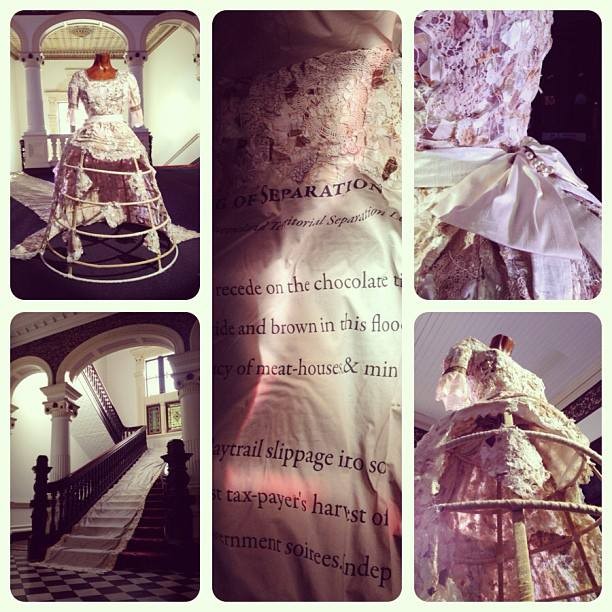1800s dream of SECESSION creates new knowledge about Rockhampton
By JOL Admin | 25 October 2013
Guest blogger: Kristin Hannaford, artist

Our exhibition in Rockhampton called Trace: Poetry, Art and the Built Environment recently took our community via a bus tour to historically significant sites. Two poets, Paul Summers and I, were commissioned to write a series of poems about the sites and to uncover intriguing stories behind them. We were then to work with selected artists to develop site specific art installations that embodied those stories. We looked at Rockhampton in the late Victorian age of the 1890s, a town caught in boomtown glory days of mining and pastoral wealth.
One site was Kenmore House, a grand building once known as ‘The Mansion’ – now functioning as part of the Mater Misericordiae hospital. The opulent house, originally built by ‘Honest’ John Ferguson in 1894, was intended as a home for the Governor of the colony of Central Queensland. Central Queensland has considered the benefits of becoming a separate state entity, or seceding from the greater state of Queensland, many times over the course of settlement history.
In reading some of Lorna McDonald’s writings on the history of the secession movement, I became aware that men were not the only ones actively involved in the secession movement. In 1892, the women’s branch of the Central Queensland Separation League petitioned Queen Victoria for a separate state of Central Queensland. That proceeds of ‘land sales swept into the Brisbane treasury’ and that there was ‘excessive taxation of breadstuffs’ were just a few of the qualms cited. The State Library of Queensland holds the original petition (Accession OM 86-05, Central Queensland Separation League Petition, 1892-1893) and provided images for use in the art installations that would embody the story and create new knowledge.
As a writer I became interested in the fact that this petition of over 3,000 signatures was signed in 1892, well before women achieved national suffrage in 1901. This seemed a very interesting and clear expression of political awareness and intent. In discussion with the other artists involved in the project, the idea of re-presenting the scroll as part of the site specific installation evolved and thanks to State Library of Queensland, images were able to be used for the reinterpretation of these significant heritage materials.
Thanks to sculptor Brendon Tohill, a 2.5 metre tall sculpture of a woman emerged. Fabric artist Julie Thornton constructed a Victorian era dress, in the colours of parchment and linen, with a 25 metre train incorporating scroll images to recreate sections of the 1892-93 petition. As viewers walked up the stairs they read of the societal status of women signatories as ‘married’, ‘single’ or ‘widowed’. The upper part of the train contains a poem of mine, ‘Song of Separation’, which was written in response to Rockhampton poet Lala Fisher’s 1890s poem of the same name; commissioned over a hundred years earlier.
In today’s political climate, it is useful to reflect on the important political issues of the past and to consider how they may have shaped current relations or sentiment between the Brisbane capital and her regional outposts. The petition represents Rockhampton’s somewhat idealistic vision of distinctiveness – its dream to claim independence from a southern capital that it felt did not represent its best interests at the time. Perhaps best of all, it can remind us of the spirit and history of women’s involvement in political endeavours in Queensland’s early history.
With contribution from C. Cottle, Digital Collection Curator, Queensland Memory
Comments
Your email address will not be published.
We welcome relevant, respectful comments.